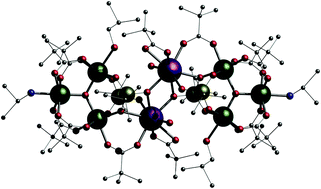Linking Cr3 triangles through phosphonates and lanthanides: synthetic, structural, magnetic and EPR studies†
Abstract
The preparation and structural characterisation of five 3d–4f mixed metal phosphonate cages with general formula [CrIII6LnIII2(μ3-O)2(H2O)2(O3PtBu)4(O2CtBu)12(HOiBu)2(iPrNH2)2] where LnIII = La, 1; Tb, 3; Dy, 4; Ho, 5 and [CrIII6GdIII2(μ3-O)2(H2O)2(O3PtBu)4(O2CtBu)12(HOiBu)4] (2) are reported. The structure contains two oxo-centred {Cr3} triangles, bridged by phosphonates and lanthanides. The magnetic behaviour of 1 has been modelled as two non-interacting isosceles triangles, involving two antiferromagnetic interactions (J1 = −8.8 cm−1) with a smaller ferromagnetic interaction for the unique edge of the triangle (J2 = +1.3 cm−1) giving an isolated S = 3/2 ground state per triangle. The quartet ground state has been proven through simulation of electron paramagnetic resonance (EPR) spectra obtained at the X- and Q-band. EPR simulations have also resulted in the introduction of small single-ion Zero Field Splitting (ZFS) parameters D = ±0.19 cm−1 and rhombic term E = ±0.02 cm−1, which are consistent with strong exchange limit calculations for an isolated S = 3/2 (D = ±0.22 and E = ±0.018 cm−1).


 Please wait while we load your content...
Please wait while we load your content...